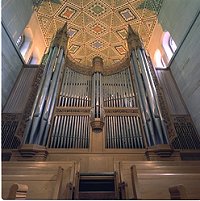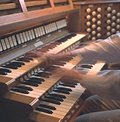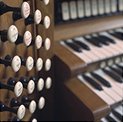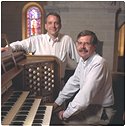Colorado College Bulletin
A Polyphonic Palette
By Robert Hill
Photographs by TOM CHERREY
First, a listing of facts: The Welte-Tripp organ in Shove Chapel weighs 40,000 pounds and contains more than 3,000 pipes ranging in size from a half-inch, sub-ounce wheatstraw to a 16-foot pipe of California sugar pine weighing more than 300 pounds. Its English Gothic spires are 30 feet tall. Its console contains three manuals with 65 draw stops. Electrical connections between keys and pipe stops once ran through more than 200 miles of copper wire.
Robert Pier Elliot, Welte's organ builder at its Connecticut plant, built the local Grace Church organ in 1928. When a New Yorker named Tripp bought Welte in bankruptcy, Elliot built the Welte-Tripp for Colorado College, the last organ to be built by the short-lived firm before it was absorbed by Kimball in a second bankruptcy. The organ was installed in 1931 by the Denver firm of Fred H. Meunier and was voiced -- or given its character -- by Richard Oliver Whitelegg, a Londoner brought by Welte to New York. Whitelegg had a characteristic touch and, according to chapel organist Frank Shelton '73, "may become over the years one of the most influential organ voicers of the 20th century."
The history of the Shove organ is a record of individual craftsmanship, expertise informed by personal taste, preserved carefully and intelligently to the satisfaction at least of the Organ Historical Society, which in 1998 designated it a historical instrument. "It really is one of the outstanding instruments of its period," Shelton says.
The original 1931 organ worked on a combination of electrical and pneumatic action. With pollution and age, the air tubes connected to little leather pouches all around the instrument began to deteriorate and break. By Shelton's appointment in 1980, the organ was literally falling apart. In 1981, in conjunction with the 50th anniversary of the chapel, the organ keyboard was renovated with solid state circuitry, more reliable than miles of wire but still pneumatic. "Solid state didn't do the whole trick," Shelton remarks. "There were times when I'd turn the organ on and the harp stop would pop right out. Sometimes the organ would just go crazy."
Professor Tim Fuller, who sustains a longstanding love for organ music, has been the "patron saint" both of the organ and its honored place in the college's cultural presence.
"I began to be interested in organ music when I started singing in choirs at an early age and was exposed to organ music of the highest order, on instruments of historic importance in the history of American organ building," says Fuller. "Not long after I arrived at CC, I realized that we had such an instrument here, now finally designated as an historic instrument by the Organ Historical Society. To return it to prominence as one of the numerous examples of CC's contribution to the arts and to the Colorado Springs community has been a high priority for me."
During his tenure as dean of the college, Fuller instituted the Distinguished Organist Series, a virtuoso series that immediately highlighted the need for serious renovation. "We had a major concert series with some of the outstanding organists in the world, and this organ only had eight general presets," Shelton recalls. Everyone who gave recitals would have to spend 10 minutes at intermission rearranging all the stops and resetting the presets." Morel and Associates, a Denver company that dates back to the creation of the instrument, gave the college a three-part proposal for renovations, the first phase of which, rebuilding the console, was completed over 18 months.

The result? Shelton raises the console's roll-top with visible excitement. "Here's the instrument of 1931. But the only thing actually the same is the original nametag. The action is more versatile, much lighter. It's more flexible. You can just play faster.
"We've changed absolutely nothing tonally," he says. "All we've done is adapt all the changes of the early '80s to a console that can actually manage it."
The new keyboard replaces the old electrical circuits with magnets, providing more flexibility. "The pipes are all enclosed in boxes, and the boxes have what are called expression shades, like Venetian blinds, that open and close," Shelton explains. "Now the shades open all the way and sound swells around the chapel."
But the real magic is the immense versatility that technology brought to the old organ. First, it is equipped with a plug-in disk drive that transmits the play to a floppy disk and permits instant replay, allowing organists to self-correct in rehearsals by literally sitting in the back of the nave and hearing themselves. Second, the addition of digital memory has increased the preset options. The buttons that preset selected stops and register the organ in preselected configurations have grown from eight to, well . . . "We've got 18 general presets, 12 of which are duplicated down here in the pedal," Shelton points out. "Then we have the manual presets, eight for each manual. Twenty-four, plus 18 general presets, and the pedal makes 54 presets. Then we have 99 levels of memory, so multiply times 99 and that's how many presets you have on the organ."
Memory makes all the difference. Organ notation includes instructions for registration changes, altering the musical color by adding, deleting or changing the combination of open stops. Beneath the new keyboard of each manual and down on the pedalboard are two buttons marked 'previous' and 'next.' These buttons instantly change registration - the combination of stops -- in any sequence the organist has preset, forward or back. "You can set up your whole series of presets the way you want them to be. This makes it possible to do more things than we ever imagined," Shelton says. "With this sequencer, I could change the registration on every single beat. I no longer have to jump all over the keyboard."

Before, Shelton had to have people stand on both sides of the organ to push or pull stops. Now an organist can preset nearly limitless registration changes and, by pushing buttons, change while playing.
For example, college composer Ofer Ben-Amots composed a sesquicentennial commission for the Shove organ, one requiring too many stop changes to be played easily on the old console. "I used about two-thirds of the presets on the old console to play just one movement of this piece," Shelton explains. "If I were to play both movements together, I wouldn't have had enough presets to do it -- I'd have to set one movement for the first half of the program, take a long pause and reset everything, and then play the second movement in the second half of the program. Now the entire piece can be preset."

Chaplain Bruce Coriell likes to emphasize that no matter how valuable the technological improvements are, they pale in comparison to the effect the renovation is having on Shove musicians. "We may have added 30 years to the life span of the college organist," Coriell jests. "Frank is like a little kid with a new toy. The redesigned console has brought new joy and excitement to music in the chapel."
Shelton will show off the new organ at a Homecoming recital on Sunday, Oct. 15, at 1 p.m. Works by Colorado College composers Carlton Gamer and Ofer Ben-Amots will be performed, as well as pieces by Weaver, Berlinski, Vierne, Parker and J. S. Bach. "The program is designed to show the great versatility of the organ, its many colors and all of the possibilities inherent in the new console," Shelton promises.
Prior to the concert, Coriell will update plans to continue the renovation process. Two remaining phases -- releathering the windcrest or air reservoir and reconditioning the reeds and flues -- are estimated to cost $200,000.
Back to Index